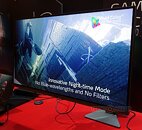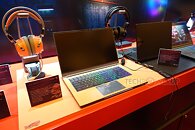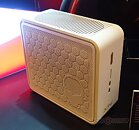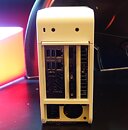Wednesday, January 8th 2020

ADATA XPG Makes Big Moves this CES: Gaming Monitors, Notebooks, and Compact Desktops for Gamers
ADATA made its biggest product portfolio expansion this year with the introduction of new product lines: gaming monitors, gaming notebooks, and compact gaming desktops. To begin with, we caught the XPG Photon, a 27-inch 4K Ultra HD gaming monitor that also has some creator-friendly features such as 95% or above DCI-P3 coverage, and implementations of Burst Refresh and Vivid Color from PixelDisplay. Gamers get not just 4K UHD resolution put out by an eye-pleasing IPS panel, but also 144 Hz refresh-rate at 4K UHD. At the flick of a toggle, the monitor can also be transformed to Full HD (1920 x 1080) at 240 Hz and 600 nits brightness. The panel supports up to 1,500 nits brightness. There's no mention of localized dimming zones, and we didn't spy DisplayHDR logos anywhere. Behind, the monitor features a triangular RGB LED lighting element that can double-up as ambient light. The stand is quite another thing: a proper studio armature with a bench clamp that allows rotation and tilting along both axes, besides height adjustment.
Next up, are the XPG Xenia line of gaming notebooks in the 15.6-inch and 13-inch form-factors. Under the hood are 9th generation Core-H processors with options ranging all the way up to Core i7-9750H, graphics options that include RTX 2070 Max-Q and GTX 1660 Ti; a combination of ADATA's homebrew hand-sorted DDR4 SO-DIMM memory and SX8200 M.2 NVMe storage; and a mechanical keyboard with RGB lighting. All of these, crammed into a magnesium-alloy body. The 15.6-inch display is IPS Full HD with 144 Hz refresh-rate. Lastly, there's the XPG Gaia line of compact gaming desktops. One of its variants is built up to "Ghost Canyon" NUC specs; while the other is a more conventional socketed thin Mini-ITX fare. Both variants are 5-liter compact, and include ADATA XPG memory and SX8000-series M.2 NVMe SSDs. You add your own compatible graphics card (up to 20 cm length). On select variants you even get Thunderbolt 3 ports.
Next up, are the XPG Xenia line of gaming notebooks in the 15.6-inch and 13-inch form-factors. Under the hood are 9th generation Core-H processors with options ranging all the way up to Core i7-9750H, graphics options that include RTX 2070 Max-Q and GTX 1660 Ti; a combination of ADATA's homebrew hand-sorted DDR4 SO-DIMM memory and SX8200 M.2 NVMe storage; and a mechanical keyboard with RGB lighting. All of these, crammed into a magnesium-alloy body. The 15.6-inch display is IPS Full HD with 144 Hz refresh-rate. Lastly, there's the XPG Gaia line of compact gaming desktops. One of its variants is built up to "Ghost Canyon" NUC specs; while the other is a more conventional socketed thin Mini-ITX fare. Both variants are 5-liter compact, and include ADATA XPG memory and SX8000-series M.2 NVMe SSDs. You add your own compatible graphics card (up to 20 cm length). On select variants you even get Thunderbolt 3 ports.





6 Comments on ADATA XPG Makes Big Moves this CES: Gaming Monitors, Notebooks, and Compact Desktops for Gamers
Why?
Laptops look all right assuming they're a Lenovo IdeaPad etc alternative (i.e. cheap allround/gaming).
It's good to see another Ghost Canyon NUC partner. That said, it's the same case design as everyone else.
I hoped we'll see at least one "large" implementation on CES (with place for more PCIe cards).
Companies aren't building PCs around the compute module ("Element"). Intel provides the general design (the case as well). And likely more modules / accessories over time if this sticks.
I'm sure we'll see more custom cases in the future, but there's hardly any need for that. This one is good looking, minimal, probably cheap as well.